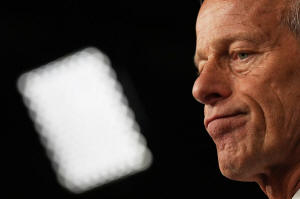Government shutdown begins as nation faces new period of uncertainty
[October 01, 2025]
By LISA MASCARO, MARY CLARE JALONICK and STEPHEN GROVES
WASHINGTON (AP) — Plunged into a government shutdown, the U.S. is
confronting a fresh cycle of uncertainty after President Donald Trump
and Congress failed to strike an agreement to keep government programs
and services running by Wednesday’s deadline.
Roughly 750,000 federal workers are expected to be furloughed, some
potentially fired by the Trump administration. Many offices will be
shuttered, perhaps permanently, as Trump vows to “do things that are
irreversible, that are bad” as retribution. His deportation agenda is
expected to run full speed ahead, while education, environmental and
other services sputter. The economic fallout is expected to ripple
nationwide.
“We don’t want it to shut down,” Trump said at the White House before
the midnight deadline.
But the president, who met privately with congressional leadership this
week, appeared unable to negotiate any deal between Democrats and
Republicans to prevent that outcome.
This is the third time Trump has presided over a federal funding lapse,
the first since his return to the White House this year, in a remarkable
record that underscores the polarizing divide over budget priorities and
a political climate that rewards hardline positions rather than more
traditional compromises.
Plenty of blame being thrown around
The Democrats picked this fight, which was unusual for the party that
prefers to keep government running, but their voters are eager to
challenge the president’s second-term agenda. Democrats are demanding
funding for health care subsidies that are expiring for millions of
people under the Affordable Care Act, spiking the costs of insurance
premiums nationwide.

Republicans have refused to negotiate for now and have encouraged Trump
to steer clear of any talks. After the White House meeting, the
president posted a cartoonish fake video mocking the Democratic
leadership that was widely viewed as unserious and racist.
What neither side has devised is an easy offramp to prevent what could
become a protracted closure. The ramifications are certain to spread
beyond the political arena, upending the lives of Americans who rely on
the government for benefit payments, work contracts and the various
services being thrown into turmoil.
“What the government spends money on is a demonstration of our country’s
priorities,” said Rachel Snyderman, a former White House budget official
who is the managing director of economic policy at the Bipartisan Policy
Center, a think tank in Washington.
Shutdowns, she said, “only inflict economic cost, fear and confusion
across the country.”
Economic fallout expected to ripple nationwide
An economic jolt could be felt in a matter of days. The government is
expected Friday to produce its monthly jobs report, which may or may not
be delivered.
While the financial markets have generally “shrugged” during past
shutdowns, according to a Goldman Sachs analysis, this one could be
different partly because there are no signs of broader negotiations.
“There are also few good analogies to this week’s potential shutdown,”
the analysis said.
Across the government, preparations have been underway. Trump’s Office
of Management and Budget, headed by Russ Vought, directed agencies to
execute plans for not just furloughs, as are typical during a federal
funding lapse, but mass firings of federal workers. It’s part of the
Trump administration’s mission, including its Department of Government
Efficiency, to shrink the federal government.

[to top of second column]
|

Senate Majority Leader John Thune, R-S.D., speaks to reporters
Tuesday, Sept. 30, 2025, at the U.S. Capitol in Washington, as the
U.S. government is on the brink of the first federal government
shutdown in almost seven years.. (AP Photo/Jacquelyn Martin)

What’s staying open and shutting down
The Medicare and Medicaid health care programs are expected to
continue, though staffing shortages could mean delays for some
services. The Pentagon would still function. And most employees will
stay on the job at the Department of Homeland Security.
But Trump has warned that the administration could focus on programs
that are important to Democrats, “cutting vast numbers of people
out, cutting things that they like, cutting programs that they
like.”
As agencies sort out which workers are essential, or not,
Smithsonian museums are expected to stay open at least until Monday.
A group of former national park superintendents urged the Trump
administration to close the parks to visitors, arguing that poorly
staffed parks in a shutdown are a danger to the public and put park
resources at risk.
No easy exit as health care costs soar
Ahead of Wednesday’s start of the fiscal year, House Republicans had
approved a temporary funding bill, over opposition from Democrats,
to keep government running into mid-November while broader
negotiations continue.
But that bill has failed repeatedly in the Senate, including late
Tuesday. It takes a 60-vote threshold for approval, which requires
cooperation between the two parties. A Democratic bill also failed.
With a 53-47 GOP majority, Democrats are leveraging their votes to
demand negotiation.
Senate Majority Leader John Thune has said Republicans are happy to
discuss the health care issue with Democrats — but not as part of
talks to keep the government open. More votes are expected
Wednesday.
The standoff is a political test for Senate Democratic leader Chuck
Schumer, who has drawn scorn from a restive base of left-flank
voters pushing the party to hold firm in its demands for health care
funding.
“Americans are hurting with higher costs,” Schumer said after the
failed vote Tuesday.

House Speaker Mike Johnson sent lawmakers home nearly two weeks ago
after having passed the GOP bill, blaming Democrats for the
shutdown.
“They want to fight Trump,” Johnson said Tuesday on CNBC. “A lot of
good people are going to be hurt because of this.”
Trump, during his meeting with the congressional leaders, expressed
surprise at the scope of the rising costs of health care, but
Democrats left with no path toward talks.
During Trump’s first term, the nation endured its longest-ever
shutdown, 35 days, over his demands for funds Congress refused to
provide to build his promised U.S.-Mexico border wall.
In 2013, the government shut down for 16 days during the Obama
presidency over GOP demands to repeal and replace the Affordable
Care Act, also known as Obamacare. Other closures date back decades.
___
Associated Press writers Matt Brown, Joey Cappelletti, Will Weissert,
Fatima Hussein and other AP reporters nationwide contributed to this
report.
All contents © copyright 2025 Associated Press. All rights reserved |